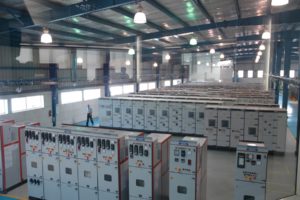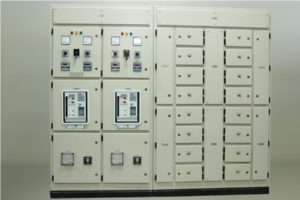 Soeb Fatehi, Immediate Past President, Control Panel and Switchgear Manufacturers’ Association (COSMA) in conversation with Venugopal Pillai shares his views on the shape of things to come for switchboard and control panel manufacturing businesses. The control panel and switchgear industry is undergoing a transformation. From a time when the industry was typified by generalists, the field is slowly beginning to be dominated by user sector specialists, much to the delight of the consumer, notes Fatehi.
Soeb Fatehi, Immediate Past President, Control Panel and Switchgear Manufacturers’ Association (COSMA) in conversation with Venugopal Pillai shares his views on the shape of things to come for switchboard and control panel manufacturing businesses. The control panel and switchgear industry is undergoing a transformation. From a time when the industry was typified by generalists, the field is slowly beginning to be dominated by user sector specialists, much to the delight of the consumer, notes Fatehi.
Do you feel that over the last few years the control panel and switchboard manufacturing industry appears to be undergoing many structural changes?
Certainly, yes! The whole market for LV control panels and switchboards is changing very rapidly. Users and buyers are thinking differently and putting forth new expectations. Bigger projects are being floated. IoT and AI are poised to dominate the future landscape.
Standardization is now demanded at every level by the market. Global players setting up projects in India are demanding parity of safety and reliability standards with their installations across the world. At ageing installations set up long ago, it is not always possible to change the entire electric distribution network, however refurbishment and modification of installations helps bring the benefits of modern automation to older sites.
What then are the ways in which the control panel and switchboard manufacturers are responding to shifting market demands and expectations? How is the industry gearing up for the future?
 Two types of changes are seen happening simultaneously. One is the change in technology and the other is the shift in user/buyer perspectives.
Two types of changes are seen happening simultaneously. One is the change in technology and the other is the shift in user/buyer perspectives.
These changes are inseparably intertwined. Higher ease of access to new technology is spurring users to imbibe futuristic thinking. Increasing emphasis on safety of the whole installation and the demand for greater consideration for life cycle cost and performance makes the buyer behave different from the past.
The earliest concept of system integrators as specialists for offering solutions on controls and automation had emerged in India in the seventies. Over the decades, it evolved to franchise operation and licence partnerships.
Small and medium sector manufacturers possess the agility to respond to fast changing market demands with economies of small operations. Large corporations possess resources and R&D capabilities along with the flywheel mass to shoulder risks of dynamic operations. Those among the small and medium businesses who understand and develop the ability to collaborate horizontally and vertically will sustain in the medium and long term in the emerging scenarios.
What in your opinion will lead to an increased demand for products offered by SME manufacturers under such agreements?
The reasons for such a rise in demand are numerous.
 One reason is that users are looking for “trusted” solutions and not just products. Control panels and switchboards (abbreviated CP&S) are products built through a process of design and engineering. The users’ specific needs are distinctly understood and analysed keeping in mind operational, functional, and performance priorities over the whole lifecycle. A combined knowledge of CP&S engineering and the specific application engineering is called for. From a field of generalists of the past, the field is slowly beginning to be dominated by user sector specialists. Some CP&S manufacturers, by specialization, are able to successfully cater to specific markets like HVAC, building segments, pharma, metal industry, marine applications, etc.
One reason is that users are looking for “trusted” solutions and not just products. Control panels and switchboards (abbreviated CP&S) are products built through a process of design and engineering. The users’ specific needs are distinctly understood and analysed keeping in mind operational, functional, and performance priorities over the whole lifecycle. A combined knowledge of CP&S engineering and the specific application engineering is called for. From a field of generalists of the past, the field is slowly beginning to be dominated by user sector specialists. Some CP&S manufacturers, by specialization, are able to successfully cater to specific markets like HVAC, building segments, pharma, metal industry, marine applications, etc.
When a specialist OEM or switchgear producer sees such an application-area specialist, an opportunity is immediately born. The opportunity initiates the creation of a relationship. The size, engineering capability and financial strength makes it possible (and expedient) for the licensor to open his arms to welcome aboard a “partner”. The SME CP&S manufacturer with his specialist application knowledge, agility and aspiration to grow, readily accepts.
. . . and how then does the customer look upon this?
The user is delighted!
The user is getting the specialist application knowledge and experience of the SME producer. The user is also getting the comfort of the flexibility of transacting with a manufacturer with an existing relationship with him. Further, the user is getting a tested and certified design with the mass of the brand of the OEM or switchgear producer thrown in behind it. The certification conforms to international standards and acceptability is therefore never a case of concern. For users who are themselves global players, the use of a certified product helps them to maintain parity across locations. The use of certified products impacts insurance costs at point of use.
The high level of standardization achieved helps in maintaining standard operation and maintenance protocols for the user.
So, everyone wins?
The way forward will be open for much more innovation — not only in technology and products — but also in innovative business models. I foresee that collaborative working will evolve many times with new formats of operation and delivery. The lifecycle cost of to the user will dominate the process of evolution as we go and grow. I for one will not hazard any guesses except that the future appears bright for those who are willing to think different, think ahead and think beyond!


